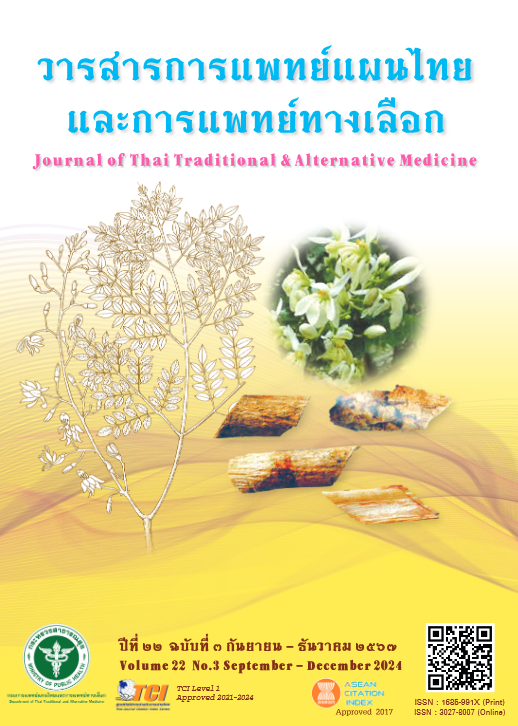Study of the Trade of CITES-Listed Medicinal and Aromatic Plants and Products in Thailand
Main Article Content
Abstract
Introduction and objectives: Many species of medicinal and aromatic plants (MAPs) are threatened by international trade, leading to extinction. The Convention on International Trade in Endangered Species of Wild Fauna and Flora (CITES) includes several MAP species in CITES Appendices. As a CITES party, Thailand has to cooperate in controlling the trade of listed plants. This study aims to investigate the trade of CITES-listed MAPs and their products in Thailand, focusing on: 1) the current situation of MAP imports and exports, 2) challenges in enforcing domestic laws as per CITES provisions, and 3) recommendations to improve the efficiency of trade control for MAPs and their products.
Methodology: This is a mixed method study, including quantitative research to analyse trade statistics of MAPs from the CITES website and relevant data from the Department of Agriculture, and qualitative research involves literature review and surveys of herbal trade on online platforms and field study at herbal shops. Data were collected using record forms and semi-structured in-depth interviews with official staffs and entrepreneurs.
Results: The trade survey of CITES-listed MAPs found 31 species sold as herbal medicines, extracts, finished herbal products, and cosmetics. Online trade showed more varieties of species and products compared with those sold in domestic stores. The species frequently found are Panax ginseng, P. quinquefolius, Saussurea costus, Aquilaria spp., and Dendrobium spp. It was also found that scientific names of some traded herbal materials were misidentified. According to trade statistics from the CITES website between 2020 and 2022, Thailand exported the highest volume of listed MAPs (49% of the global export volume), with Dendrobium hybrids as the most exported species. During this period, reports indicated 158 export instances covering 35 species of MAPs from CITES parties to Thailand, while Thailand reported only 43 import instances of 21 species. Interviews with stakeholders revealed a lack of understanding regarding the species and regulations governing the trade of CITES-listed MAPs.
Discussion: This study reveals that the control of trade in CITES-listed MAPs and their products in Thailand is inefficient. This is not due to flaws in domestic laws, but partly due to the lack of knowledge and understanding among stakeholders regarding the trade in CITES-listed MAPs and their products.
Conclusion and recommendations: It is essential to enhance the effectiveness of trade control for MAPs and their products by establishing a comprehensive database of MAPs listed in CITES and integrating information among relevant agencies. Furthermore, training and provision of information via appropriate channels should be offered to educate officials, traders, and manufacturers involved in lawful practices regarding the trade of CITES-listed MAPs.
Article Details

This work is licensed under a Creative Commons Attribution-NonCommercial-NoDerivatives 4.0 International License.
References
The World Bank. Strategic segmentation analysis : Nepal : Medicinal and aromatic plants [Internet]. 2018 [cited 2023 Nov 15]; Available from: https://documents1.worldbank.org/curated/en/496421556737648658/pdf/Medicinal-and-Aromatic-Plants.pdf
Schippmann U, Leaman D, Cunningham AB. A comparison of cultivation and wild collected of medicinal and aromatic plants under sustainability aspects. In: Bogers RJ, Craker LE, Lange D, editors. Medicinal and Aromatic Plants: Agricultural, Commercial, Ecological, Legal, Pharmacological and Social Aspects. (Wageningen UR Frontis series; No. vol. 17). Springer; 2006. p. 75-95, Available from: https://library.wur.nl/ojs/index.php/frontis/article/view/1225
CITES Secretariat. CITES implementation for trade in medicinal plant species (working document (CoP18 Doc. 55) [internet]. 2019 August 17-28 [cited 2024 Jan 25]; Available from: https://cites.org/sites/default/files/eng/cop/18/doc/E-CoP18-055.pdf
Jenkins M, Timoshyma A, Cornthwaite M. 2018. Wild at home: exploring the global harvest, trade and use of wild plant ingredients. TRAFFIC International, UK. 43 p.
Plants Act B.E. 2518 (1975) amended by Plants Act (No.2) B.E. 2535 (1992). Published in Government Gazette, Vol. 109, Part 40. (1992 April 7). (in Thai)
The CITES Species. [Internet] 2023 August 23 [cited 2023 Dec 15]; Available from: https://cites.org/eng/disc/species.php
Furnell S, Timoshyna A. Potential of certification schemes to support management and scientific authorities with the implementation of CITES Appendix II measures for medicinal and aromatic plant species (Information documents (PC24 Inf. 12)) [internet] 2018 July 20-21 and 23-26 [cited 2024 Jan 25]; Available from: https://cites.org/sites/default/files/eng/com/PC/24/Inf/E-PC24-Inf-12.pdf
Choi JA. CITES-listed medicinal plant species (Information documents (PC23 Inf. 10)) [internet] 2017 July 22 and 24-27 [cited 2023 Nov 15]; Available from: https://cites.org/sites/default/files/eng/com/pc/23/inf/E-PC23-Inf-10.pdf
Notification of the Ministry of Agriculture and Cooperatives on Conserved Plants. Published in Government Gazette, Vol. 138, Part 167D. (2021 July 22). (in Thai)
Notification of the Department of Agriculture on Criteria, Procedures, and Conditions for Issuing CITES Permits for Import, Export, and re-Export of Conserved plants under the Plant Act. B.E. 2518 (1975). Published in Government Gazette, Vol. 136, Part 79D. (2019 March 22). (in Thai)
Plant Quarantine Act B.E. 2507 (1964). Published in Government Gazette, Vol. 81, Part 27, dated 21 March B.E. 2507 (1964). (in Thai)
CITES Wildlife TradeView. [Internet] 2023 August 23 [cited 2023 Dec 15]; Available from: (https://tradeview.cites.org/en/overview)
CITES Trade database. [Internet] 2023 August 23 [cited 2023 Dec 15]; Available from: (https://trade.cites.org/)
Meeting document of the Conference of the Parties CoP1-CoP19. [Internet] 2023 August 23 [cited 2023 Dec 15]; Available from: https://cites.org/eng/meetings/cop?page=1
Medicinal Plants Names Services. [Internet] 2023 August 23 [cited 2023 Dec 15]; Available from: https://mpns.science.kew.org/
Office for the Management of Cannabis and Kratom in Thai Traditional Medicine. [Internet] Herbs in traditional Thai medicine recipes announced to be category 5 narcotics recipes that contain cannabis, which are permitted to be consumed to treat diseases or for research studies, according to the appendix of the Ministry of Public Health Announcement on the determination of category 5 narcotics recipes that contain cannabis, which are permitted to be consumed to treat diseases or for research studies, B.E. 2019 [Internet] [cited 2024 Jun 3]; Available from: (https://ockt.dtam.moph.go.th/images/Document/1. Herbs in traditional Thai medicine formulations that include cannabis.pdf) (in Thai)
CITES Secretariat. 2018. CITES Implementation for medicinal plant species (Information documents (PC24 Inf. 7)) [internet] 2018 July 20-21 and 23-26 [cited 2023 Dec 15]; Available from: https://cites.org/sites/default/files/eng/com/pc/24/Inf/E-PC24-Inf-07.pdf


